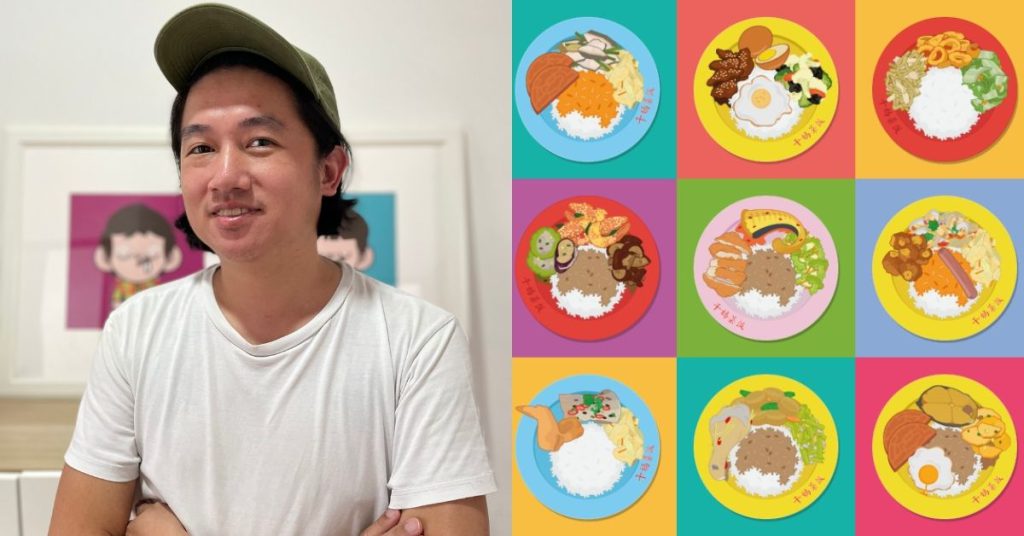Looking at Yawn of the Apes, a little hobby project by a Malaysian residing in Singapore, you’d have assumed it was started when the NFT hype began taking over this region.
Each ape on the site takes on a similar base silhouette but is then differentiated by its colour, hair, clothing, accessories, and more, based on pop culture influences. They’re very reminiscent of how generative art NFTs look like today.
Did you know: In generative art, the programme or code randomly selects different graphic elements and layers them on top of each other to create a new and unique art piece. The more traits you create, the more unique art pieces you can generate. It’s the method used by popular NFT projects such as the Bored Ape Yacht Club, CryptoPunks, Pudgy Penguins, PhantaBear, and more, to create their collections.
The truth though, is that Wan Tsau has been creating Yawn of the Apes art since 2018, long before the NFT movement ever made it to our shores.
In mid-2021, when he saw the traction that some generative art NFT projects were getting, he decided to take a deeper look into the space.
Come January 2022, and he’s finally launched his first NFT project, Chapfans, which he describes as the “most expensive cai fan (economy rice) in Singapore” and by extension, Malaysia.
A tribute to the humble cai fan
Wan Tsau chose economy rice as the subject of his NFT project due to the diversity of dishes available, referencing the seemingly-endless possibilities of cai fan dishes we could create in real life.
For Chapfans, he’s created 50 types of dishes, 3 types of gravy, 5 types of plates, and 9 background colours. From those, he’s generated 388 plates of Chapfans for his first collection, each being sold at a floor price of 0.04 ETH (about RM409 at the time of writing) on OpenSea.

But there’s another more heart-warming reason behind it. Through Chapfans, he’s able to constantly relive good childhood memories of his time growing up in KL.
Back then, he and his friends would frequent a back-alley economy rice stall off Petaling Street that was run by a few elderly and very maternal old ladies.
“They would call all the schoolboys and girls, ‘chai’ and ‘loi’ (son and daughter in Cantonese). Which is why we started calling the place ‘kai ma’s’ which means godmother’s in Cantonese,” Wan Tsau shared in an interview with Vulcan Post.
“This memory is the creative inspiration for my first Chapfans collection and [it] is called “Kai Ma Cooked Food”, a fictional tribute to the elderly ladies who fed us when we were schoolboys.”

It’s a memory that no doubt many Malaysians and Singaporeans would similarly share, but I wondered if Chapfans’ cultural influence that’s very specific to us would close it off to communities in other countries.
Wan Tsau agreed that it’d be less relevant to non-local collectors, however, he was clear on wanting to focus on something closer to his heart and that had a clear collector base.
Learning how to create NFTs online
The ability to create scarcity for his collectors was the concept that drew him to NFTs in the first place, after all.
“I used to trade and sell trading cards in primary school. A bunch of us pooled together money and I would go to the store to pick up whole boxes of cards to sell,” Wan Tsau reminisced.
“We would open up all the packs and price each card differently and according to its scarcity. The blockchain, NFTs, and smart contracts now allow us to recreate this scarcity for digital products.”

Though a new ball game, Wan Tsau quickly picked up the knowledge necessary to start Chapfans through YouTube videos alone, despite his zero coding experience.
Thankfully, by the time he began venturing into NFTs, there were more documentation and free code/solutions (like the Hashlips Art Engine) for generative art projects.
Learning from scratch wasn’t particularly a challenge for him though, since he’s also a self-taught graphic artist with no formal background in art. As he put it, “I just enjoy the creative process very much.”
Channelling his inner Andy Warhol
In between the 3+ months that he was making Chapfans, Wan Tsau was working his full-time job as the sole creative lead and illustrator at Piqolo Kids (and still is, today).
Piqolo Kids is a small publisher in Singapore making comics and activity books on exploration and creativity for children. It also makes custom children’s activity books for hotels and the hospitality sector.

This coupled with his experience creating the ape-like avatars for Yawn of the Apes meant that his time spent on drawing all the different dishes could be cut down.
“That being said, I think everyone with access to a PC and a simple illustration software will be able to jump into the generative NFT art scene very quickly,” Wan Tsau added.
His goal with Chapfans is now to rally the local NFT community to support the humble cultural icon, cai fan, and hopefully create an exclusive pop art movement not unlike what Andy Warhol did with the Campbell Soup cans.
To date, he’s had a few buyers and will be looking to airdrop some plates in the coming weeks to grow the community.
“I’m currently looking at creating more buzz with different industries from food brands, art collectors, and also lifestyle and home décor folks.”
“I’m also looking to expand into collectible prints and merchandise. But most importantly, I want to get my collectors to be more involved in the direction of the brand,” Wan Tsau concluded.
- To get in contact with Wan Tsau, you can join Chapfans’ Discord server here.
- Read more NFT content here.
Featured Image Credit: Wan Tsau, creator of Chapfans











